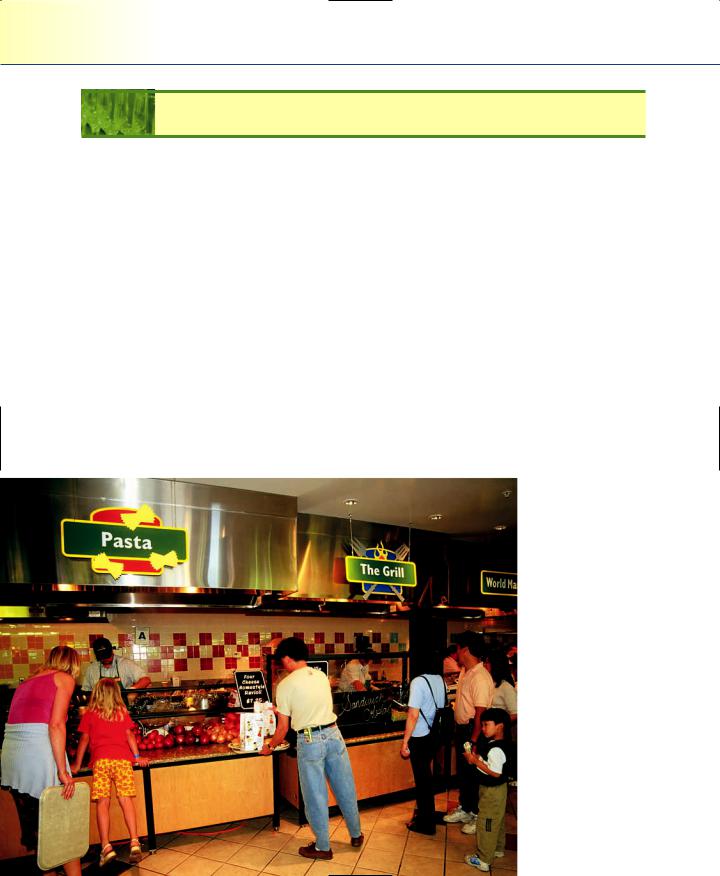
- •CONTENTS
- •PREFACE
- •Content—Benefits for Students
- •Content—Benefits for Instructors
- •Features of the Book for Students and Instructors
- •Supplementary Materials
- •Acknowledgments
- •What Is Hospitality Management?
- •The Manager’s Role in the Hospitality Industry
- •Why Study in a Hospitality Management Program?
- •Planning a Career
- •Employment as an Important Part of Your Education
- •Getting a Job
- •Employment at Graduation
- •The Outlook for Hospitality
- •Summary
- •Managing Change
- •Demand
- •Supply
- •Workforce Diversity
- •The Impact of Labor Scarcity
- •Summary
- •The Varied Field of Food Service
- •The Restaurant Business
- •The Dining Market and the Eating Market
- •Contemporary Popular-Priced Restaurants
- •Restaurants as Part of a Larger Business
- •Summary
- •Restaurant Operations
- •Making a Profit in Food Service Operations
- •Life in the Restaurant Business
- •Summary
- •Chain Restaurant Systems
- •Independent Restaurants
- •Franchised Restaurants
- •Summary
- •Competitive Conditions in Food Service
- •The Marketing Mix
- •Competition with Other Industries
- •Summary
- •Self-Operated Facilities
- •Managed-Services Companies
- •Business and Industry Food Service
- •College and University Food Service
- •Health Care Food Service
- •School and Community Food Service
- •Other Segments
- •Vending
- •Summary
- •Consumer Concerns
- •Food Service and the Environment
- •Technology
- •Summary
- •The Evolution of Lodging
- •Classifications of Hotel Properties
- •Types of Travelers
- •Anticipating Guest Needs in Providing Hospitality Service
- •Service, Service, Service
- •Summary
- •Major Functional Departments
- •The Rooms Side of the House
- •Hotel Food and Beverage Operations
- •Staff and Support Departments
- •Income and Expense Patterns and Control
- •Entry Ports and Careers
- •Summary
- •The Economics of the Hotel Business
- •Dimensions of the Hotel Investment Decision
- •Summary
- •The Conditions of Competition
- •The Marketing Mix in Lodging
- •Product in a Segmented Market
- •Price and Pricing Tactics
- •Place—and Places
- •Promotion: Marketing Communication
- •Summary
- •The Importance of Tourism
- •Travel Trends
- •The Economic Significance of Tourism
- •The United States as an International Tourist Attraction
- •Businesses Serving the Traveler
- •Noneconomic Effects of Tourism
- •Summary
- •Motives and Destinations
- •Mass-Market Tourism
- •Planned Play Environments
- •Casinos and Gaming
- •Urban Entertainment Centers
- •Temporary Attractions: Fairs and Festivals
- •Natural Environments
- •On a Lighter Note. . .
- •Summary
- •Management and Supervision
- •The Economizing Society
- •The Managerial Revolution
- •Management: A Dynamic Force in a Changing Industry
- •What Is Management?
- •Summary
- •Why Study Planning?
- •Planning in Organizations
- •Goal Setting
- •Planning in Operations
- •The Individual Worker as Planner
- •Long-Range Planning Tools
- •Summary
- •Authority: The Cement of Organizations
- •Departmentalization
- •Line and Staff
- •Issues in Organizing
- •Summary
- •Issues in Human-Resources Management
- •Fitting People to Jobs
- •Recruiting
- •Selection and Employment
- •Training
- •Retaining Employees
- •Staff Planning
- •Summary
- •The Importance of Control
- •Control and the “Cybernetic Loop”
- •Tools for Control
- •Summary
- •Leadership as Viewed by Social Scientists
- •Why People Follow
- •Leadership Theories
- •Communication
- •The Elements of Leading and Directing
- •Developing Your Own Leadership Style
- •Summary
- •A Study of Service
- •Rendering Personal Service
- •Managing the Service Transaction
- •How Companies Organize for Service
- •Summary
- •INDEX

64 |
Chapter 3 The Restaurant Business |
The Varied Field of Food Service
The word restaurant covers a broad range of food service operations. The term comes from the French word restaurant, meaning “restorer of energy.” The term was used as early as the mid-1700s to describe public places that offered soup and bread. Today, any public place that specializes in the sale of prepared food for consumption onor off-premise can be described as a restaurant. Food service is generally used to represent the broader term, which encompasses all sorts of public and private
locations that provide food for sale.
Food service is a basic part of the North American way of life and a growing part of life in other parts of the world. Americans are expected to spend 53 percent of their food budget (or food dollar) on food away from home by 2010 (they currently spend just less than 50 percent).1 Most of that amount was spent in commercial restaurants, as described above. Virtually everyone in North America has eaten in a restaurant, and on average, roughly half the population eats in a restaurant at least once in any given month. In fact, in a survey conducted by Restaurants & Institutions magazine, it was found that 98 percent of households surveyed ate out in the prior month.2
Food service plays an important role in all environments including tourism destinations. (Courtesy of LEGOLAND® CALIFORNIA.)

The Varied Field of Food Service |
65 |
Food away from home may be purchased in a variety of locations. This speaks to the size and scope of the food service industry that includes employee cafeterias, convenience stores, traditional restaurants, hotel facilities, casinos, and taverns, among others. Most of these segments are experiencing positive growth—a trend that has been sustained for over a decade (the industry even experienced positive growth in 2001, a year that brought a whole host of challenges). In 2006, full-service restaurants increased by 5.2 percent and quick-service restaurants by almost 5 percent.3
In fact, all major commercial segments experienced positive growth.
The other major food service sector, on-site food service (sometimes referred to as institutional or noncommercial food service), represents a smaller but equally important part of the greater food service industry. (Chapter 7 discusses the on-site sector of the industry in depth.) This part of the industry is composed of contractors and caterers (who serve food in places such as manufacturing plants and office buildings, health care facilities, and schools and colleges) and those institutions that own and operate their own food service (self-ops). Managed services (the contract side) account for 6.5 percent of total food service industry sales, while those that provide their own generate 8.2 percent of sales. An additional 3.6 percent of sales are made through vending machines. Approximately 14 percent of food-away-from-home expenditures are accounted for by the on-site market. These estimates are summarized in Table 3.1.
TABLE 3.1 |
|
|
The Major Areas of Food Service, 2006 |
|
|
|
FOOD AND DRINK SALES (2006)a |
|
|
SALES ($ BILLIONS) |
PERCENTAGE OF TOTAL |
Eating places |
345.2 |
67.6 |
Bars and taverns |
15.7 |
3.1 |
Food service in lodging |
25.0 |
4.9 |
Managed services |
34.0 |
6.7 |
Other commercial |
47.7 |
9.3 |
Institutions operating own |
|
|
food service |
41.6 |
8.1 |
Military |
1.8 |
0.3 |
TOTAL |
511.0 |
100.0 |
aDollar amounts and percentages shown are based on estimates for 2006 made by the National Restaurant Association.
Source: National Restaurant Association, 2006 Restaurant Industry Forecast, December 2006, p. 10.

66 |
Chapter 3 The Restaurant Business |
The relative shares of the market held by the segments identified in Table 3.1 tend to be rather stable from year to year. Such seeming stability, however, hides important evolutionary processes that are going on within each category. In fact, the industry is in the throes of change.
Although food service sales overall grew 5.1 percent between 2005 and 2006, some areas have actually decreased. Within the employee restaurant services segment (employee cafeterias and dining rooms) there was a significant decrease (mostly a result of businesses outsourcing their food service to managed-services companies) as well as decreases in self-operated secondary schools and colleges and universities food service operations.
For some years, the biggest growth in food service has been in operations such as takeout, drive-through, and delivery, which we will call collectively off-premise sales. In fact, off-premise food service has accounted for the lion’s share of the growth in total restaurant sales since the late 1980s. Even though on-premise (i.e., in-restaurant) sales have increased each year since 1992, off-premise sales have done even better in recent years. Off-premise options are no longer limited to quick-service restaurants (QSR), either. One of the growth areas is in full-service restaurants with higher-than-average check averages, although fast food and pizza still command a large share of this market. (The average check represents the amount that the “average” customer spends and is calculated by dividing the total food and beverage sales for the period by the total number of customers for the period). Bennigan’s, a casual dining chain, has recently added separate entrances (and service systems) for their takeout customers. The trend in many segments of the restaurant industry is toward a higher proportion of takeout, delivery, and drive-through.
During the 1960s and 1970s, quick service altered dramatically the meaning of what a restaurant was. The trend toward off-premise consumption suggests that another fundamental change in the business definition of restaurants may be evolving.
Another set of changes involves fine dining, for years the mainstay of the upscale restaurant segment. By and large, fine dining, with its trappings of formality, has been declining in relative importance, whereas casual dining has been growing very rapidly. To some degree, fine dining’s decline appears to be a result of consumers’ apparent interest in value in food service and a sensitivity to the relatively high prices fine dining must charge. Today’s consumers also are more predisposed to a casual dining experience. Food tastes are changing as well. All of these changes have resulted in a change in the way that the fine dining experience is perceived. Some suggest that the decline is just part of a cycle, though, and that fine dining will someday achieve its previous stature.
Many of the changes in food service result from changes in the age composition of North America’s population, as discussed in earlier chapters. Members of the huge

The Restaurant Business |
67 |
generation born in the 20 years following World War II, the baby boomers, have entered middle age. As they do so, their lifestyles have changed. They were raised with fast food and prefer an informal ambience. Now, as parents, they find a casual atmosphere more comfortable for the whole family. More will be said about the importance of casual dining later in the chapter.
Quick-service restaurant (QSR) sales continue to rise also, by 2.3 percent in 2006 over 2005. Furthermore, as we noted, sales in casual-dining restaurants are rising rapidly, too. Finally, we should note that on-site sales have also shown healthy growth, with contractors and caterers (private companies providing food service to institutions) continuing to capture market share from self-operated units even in segments that have traditionally been self-operated, such as public schools.
THE OUTLOOK FOR FOOD SERVICE
One authoritative study suggested that “by the year 2005, many Americans will have never cooked a meal from basic ingredients.”4 Now that we can view this statement from a historical perspecive, we can determine that it was made with a great deal of accuracy. Considering the trends, this statement has proven to be very true. People are apparently less willing to spend the time to cook their own food, which suggests growing business for those of us in the business of providing food to people away from home.
Gains in restaurant traffic are outpacing population gains by a significant factor. Customers are also generally pleased with the value they receive at restaurants. According to the National Restaurant Association, 81 percent of customers of moderately priced full-service restaurants indicated that their expectations regarding value were met or exceeded, while seventy-five percent of quick-service restaurant customers said that their expectations were met or exceeded.5
Finally, the study cited earlier concludes that changes in demographics and lifestyles will combine to produce “the greatest decade of growth the food service industry has ever known.”6
The Restaurant Business
Describing the restaurant business is like trying to hit a moving target: The restaurant market is constantly changing. One could go so far as to say that it is constantly reinventing itself. There are so many types of restaurants that it is difficult to devise a model to fit them all. Nevertheless, we need some basic terminology to de-
scribe the field, even if in general terms.
